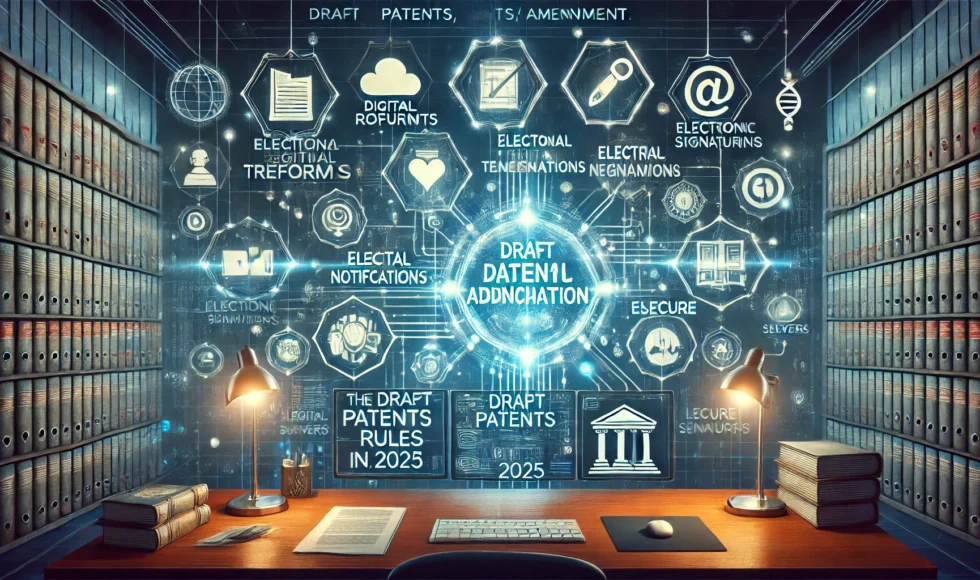Introduction
Over the past few years, Indian patent practice has seen a steady transformation, shaped by global best practices, demands of various reforms for efficiency, and constructive legislative initiatives such as the Jan Vishwas Act reforms. The publication of the Draft Patents (Amendment) Rules, 2025, strengthen this encouraging trend in patent practice.
These draft rules attempt to reengineer the procedural framework for adjudication of contraventions under Sections 120, 122 & 123 of the Patents Act, 1970 by incorporating digital adjudication, prescribed timelines, and standardized forms. In essence, an end-to-end electronic process has been proposed that would commence from filing a complaint up to an appeal, thereby tightening inquiry and appellate timelines so as to ensure accountability of the concerned person. These changes are centered around improving complaint resolution, ensuring digital integration, and laying down a structured framework for inquiries, appeals, and penalties—especially concerning violations under Sections 120, 122, and 123 of the Act.
The 2025 Draft carries directly from the Jan Vishwas Amendments which had inserted Chapter XIV-A into the Patents Act to create Sections 124A–124B regarding the institution of adjudicating officers and a departmental appeal in place of criminal proceedings for some offences. With that basic setup existing, the new draft rules further finetune the mechanism, improve more clarity in procedures, and strengthen due process.
Statutory Backdrop
The Jan Vishwas (Amendment of Provisions) Act, 2023 had set about initiating a shift in policy by decriminalizing minor offenses under several laws, including intellectual property statutes. This objective come into picture under the Patents Act in the 2024 amendments, by inserting the new Chapter XIV-A.
This chapter inserted Section 124A enabling the Central Government to designate adjudicating officers for conducting inquiries with respect to contraventions under Sections 120, 122, and 123. In addition, an appeal mechanism within the department has been provided under Section 124B where any person aggrieved by the order of an adjudicating officer shall have a right to appeal within sixty days to such appellate authority as may be prescribed by the Central Government.
The offences covered are significant in practice:
- Section 120 penalizes unauthorized claims of patent rights, such as false patent marking or misrepresentation.
- Section 122 targets failure to furnish information or refusal to provide required statements to the Controller or Central Government.
- Section 123 penalizes unregistered individuals practicing as patent agents.
These laws cover aspects related to compliance, transparency, and the integrity of the patent system. The Draft Rules of 2025 thus seek to give effect to the intent of this statutory design with an emphasis on procedural clarity and digital enablement.
Core Features of the Draft Rules
Definitions and Scope
With the introduction of new Rules 107A to 107G, the draft has replaced the old rules and annexed new provisions. Rule 107A is of primary importance as it defines fundamental concepts related to adjudicating officers, appellants, and appellate authorities and their corresponding Sections (124A and 124B). This aligns with the statutory framework of the Act, and eliminates the possibility of interpretational ambiguities.
Filing of Complaints
Rule 107B outlines the complaint initiation process. Any individual wishing to contact the predetermined mail address complaints of the Chapters 120, 122 and 123 contraventions electronically by using the newly created Form 32. This complaint, as under the procedure, has to be accompanied by specific particulars and requisite evidence, which is a significant change compared to the previous informal structure of complaints, as the previous method created a delay in commencing formal proceedings.
Inquiry Process
The Rule 107C outlines the steps to be followed in conducting the inquiry. Once a complaint is received, the adjudicating officer electronically sends a show cause notice and gives at least 7 days for the accused to respond to that notice. The officer has the authority to hear evidence and is granted special powers in that the officer is not bound by the Bharatiya Sakshya Adhiniyam, 2023, which gives flexibility in the treatment of documents and records, be they in paper or electronic form.
The officer has the power to compel the attendance of the witnesses, direct the production of documents, and in the absence of compliance, proceed ex parte, provided reasons are recorded. Importantly, inquiries are required to be concluded within three months from the date of notice, introducing a much-needed element of predictability.
Appeals
Rule 107D is to operationalize the appellate mechanism under the Section 124B, and the said appeal has to be preferred electronically, as for the filing of the form, a new Form 33 is enacted, and shall be presented within the period of 60 days from the date on which the Order made by the Adjudicating Officer. A reply period is also provided to the respondent to the appeal, and the Appellate Authority is required to issue a reasoned order. Appeals are to be ordinarily completed within six months, subject to extensions where justified.
Electronic Service and Filing
Rule 107E requires that all communications, submissions, and service of documents are handled electronically. Proof of delivery requires correct addressing and delivery, matching the patent adjudication process to much broader e-governance criteria.
Extension Powers
Rule 107F empowers the adjudicating officers and the appellate authorities to extend the time lines or reckon the delay for good and sufficient reasons. Extensions are or may be granted with or without imposition of costs allowing for a measure of discretion while not compromise the emphasis on timely adjudication.
Orders and Penalties
Finally, Rule 107G requires that all orders be dated, digitally signed, communicated to the parties, and uploaded on the official Patent Office website. This enhances transparency and ensures record integrity. Additionally, all penalties realized are to be credited to the Consolidated Fund of India, reinforcing budgetary accountability.
Our Analysis of the Draft Rules
- Strengthening Due Process – The Draft Rules strive to be both efficient and fair. On the one hand, minimum response periods and deadlines serve as protection against excessive delay; but on the other a mechanism of this kind must include safeguards to avoid undue disadvantages to the respondent, such as reasoned ex parte decisions and right of extension.
- Digital Transformation – The draft rules advance the move to electronic adjudication imposing e‐filing, service and orders. This is in line with Government of India’s larger initiatives, such as the Digital India mission, and would decrease dependence on physical records, postal department and manual interventions. For the parties involved, it would also mean prompt communication, improved traceability and less cost in procedures.
- Predictability and Accountability – The codification of deadlines — three months for inquiries and six months for appeals — is a major step forward. Patent adjudication has often been criticized for uncertainty, and the timeframes involved offer the kind of predictability that parties can plan for. More importantly, the need for digital signing of reasoned orders will ensure that efficiency is not at the cost of accountability.
- Broader Policy Context – The draft rules should be considered as just one step amongst a broader set of reforms. Those 2024 amendments were structural — in that they brought adjudication and appeals features into the Patents Act. The 2025 draft is a natural next step, aiming for operational clarity, digital transition and access convenience for the parties involved. They also signify India’s commitment to harmonizing its IP processes with global trends, where administrative adjudication and digital governance are quickly becoming the general practice across the department. The rules enhance the accountability within the government finances by crediting penalties in the Consolidated Fund of India.
Conclusion
The Draft Patents (Amendment) Rules, 2025, represents a strong step towards time-bound, transparent and electronic resolution under the Indian patent regime. The rules enforce due process by providing relevant procedural specificity, requiring electronic processes, and imposing timelines, while addressing longstanding complaints regarding delay and inefficiency.
The procedure given in the draft amendment focuses on easier access and speedier resolution for complainants. It guarantees respondents basic due process and fairness via comprehensible and clear timelines and procedural protections. It represents a shift towards a modern governance in the patent ecosystem at large and brings the patent adjudicatory mechanism in tune with India’s wider digital transformation agenda.
If notified as is, these set of draft amendment rules, would not only fine-tune the post-Jan Vishwas act but also mark a major step in the development of a framework for enforcement of intellectual property in India.
Further, Public Participation Invited: Comments/suggestions can be submitted within 30 days from the Gazette publication to ipr-patents@gov.in.

